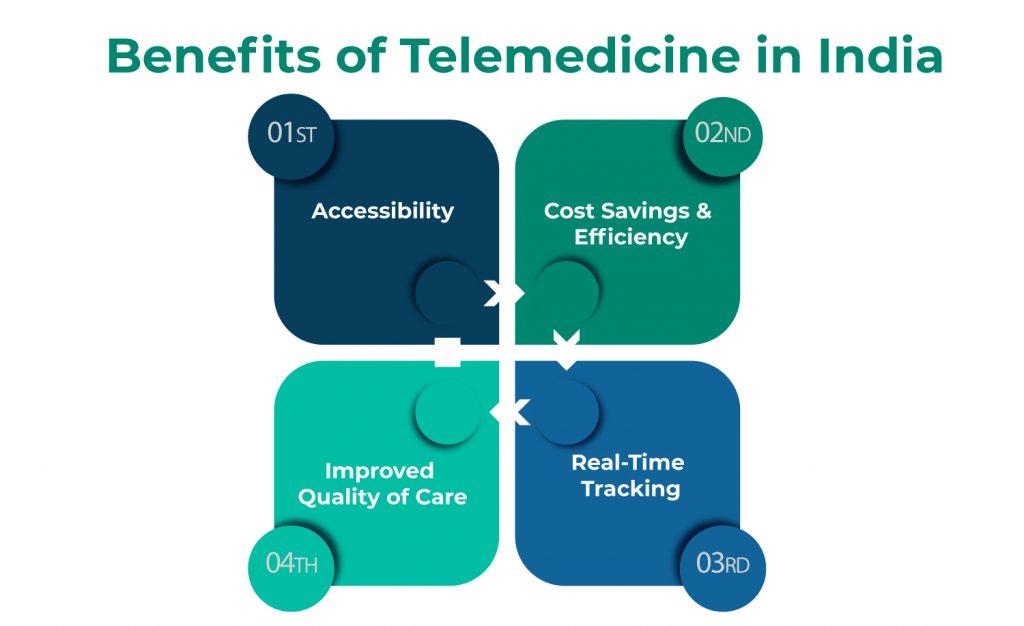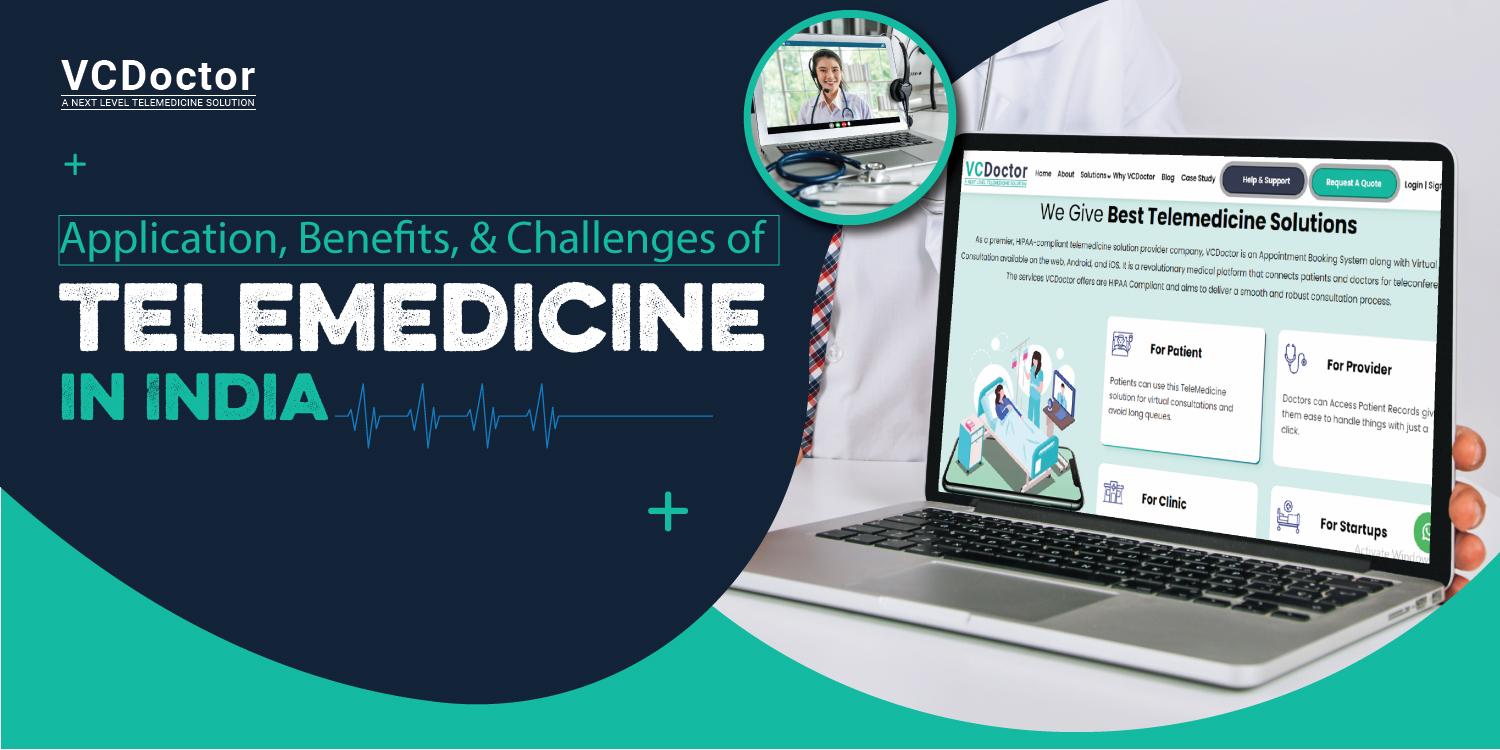Application, Benefits, and Challenges of Telemedicine in India
Telemedicine services include the use of electronic communications and software to get treatment without visiting a doctor’s place. This technology is mostly used for the treatment of old diseases, management of medication, virtual visits, specialist consultation and a host of other clinical services which can be provided remotely through secure video and audio connections. So telemedicine in India is also known as “video visits,” or “online doctor visits,” and can be implemented through smartphones, tablets, or computers.
Table of Contents
- Applications of Telemedicine in India
- White Label Telemedicine Solutions
- Benefits of Telemedicine in India
- How Is Telemedicine Different From Traditional Healthcare Systems?
- Finding a Reliable Telemedicine App Development Company
- Challenges of Telemedicine in India:
- Telemedicine Guidelines in India:
- Conclusion:
- FAQs
Applications of Telemedicine in India
Telemedicine in India has a number of use cases. The primary among these include:
- Remote patient monitoring,
- Disease management, and
- Mental health counselling.
In addition to being able to diagnose and cure patients as soon as possible. Telemedicine can be used to virtually monitor patient vitals and notify medical professionals of any potential issues or emergencies. It also facilitates easy monitoring of people with chronic illnesses without a trip to the doctor’s office.
Last but not least, Video conferencing in healthcare can make mental health services like therapy and counselling more accessible. Patients who might not otherwise have simple access to them can get the support they need from the comfort of their homes.
White Label Telemedicine Solutions
White-label solutions offer a number of benefits, such as:
- Easy implementation: White-label telemedicine solutions are simple to set up and don’t require significant time or investment.
- Increased efficiency: White-label telemedicine solutions also increase process efficiencies such as e-prescriptions, auto-billing, scheduling, and much more.
- Greater patient engagement: Patients feel more informed about their treatment options and can access healthcare services, regardless of location or time constraints.
- Improved quality of care: Popular telemedicine services also support electronic medical records. This allows providers to offer more personalized care and provide real-time feedback on treatments and medications.
Benefits of Telemedicine in India
When it comes to the benefits of telemedicine in India, there are plenty!

Accessibility
People who live in rural regions can gain much-needed access to doctors and specialists. Additionally, it improves accessibility for those who might find it challenging to get to a doctor’s workplace because of a disability, physical restrictions, or a busy schedule.
Cost Savings and Efficiency
As patients can get medical advice from their homes, they end up saving money on travel, consultation, and treatment costs. Additionally, telemedicine can help shorten wait times as well as avoid standing in queues.
Improved Quality of Care
Because it gives physicians quicker access to medical information, telemedicine enhances the quality of care provided to patients. Additionally, caregivers can also collaborate better, giving patients access to a wider range of experts.
Real-Time Tracking
Last but not least, telemedicine helps doctors and specialists track patient vitals like blood pressure or glucose levels in real time. Telemedicine for providers can help swiftly diagnose any changes in a patient’s health.
How Is Telemedicine Different From Traditional Healthcare Systems?
Telemedicine is miles ahead of traditional healthcare systems. Let’s take a look at how.
Low Cost
Telemedicine is a less expensive option to conventional in-person medical treatment. Plus, patients can access doctors with specializations at a fraction of the usual cost.
Convenience
Patients who use telemedicine don’t have to travel to the doctor’s office or stand in line, which is a huge benefit for them. All they require is a smartphone or computer, and an internet connection.
Effectiveness
Telemedicine reduces health risks associated with waiting a long time before seeking a diagnosis or treatment by making access to medical consultations simpler.
To summarise, By enabling more people to easily access medical care without incurring excessive travel expenses or waiting periods, telemedicine can considerably improve patient outcomes.
Finding a Reliable Telemedicine App Development Company
Whether you are a startup, clinic, hospital, or private practitioner, working with a reputable telemedicine app development company is essential. With a quality development team behind you, you’ll be able to maximize the benefits of telemedicine technology. Here are some of the things you should look for:
1. Experience:
Select a company that has expertise in creating apps for your industry. They must be willing to share testimonials/feedback from previous customers, as well as offer training sessions for staff and doctors on how to use the app.
2 Cost-effectiveness:
Verify that the company has transparent pricing plans that fit your budget. Also, ensure that the solutions are easy to scale so you can easily update them in the future without going over budget.
3. Support:
A good telemedicine app development company will give their clients ongoing support when required. This includes round-the-clock customer support, bug fixes, and routine upgrades to make sure your system is always operating efficiently.
Challenges of Telemedicine in India:
While telemedicine is a powerful technology to help patients through video calls at a lower cost, still there are several challenges of telemedicine in India. Some challenges are discussed below:
Lack of Confidence:-
The patients do not trust telemedicine outcomes fully and that is the biggest challenge of Telemedicine. It is hard to believe for them that how an online app can give the prescription or healthcare demands without an in-person visit or without a visit to a hospital. This culture or attitude is a barrier to the adoption of telemedicine in India.
Lack of Awareness:-
The biggest problem with telemedicine is the patients’ lack of knowledge. The majority of people are still unaware that telemedicine gives them the choice to speak with or chat with doctors. The primary issue is awareness. There needs to be a comprehensive support plan- a private-public partnership of some sort to encourage telemedicine adoption at scale.
Save time and money on healthcare appointments: VCDoctor Telemedicine Services
Telemedicine Guidelines in India:
Some of the basic guidelines of telemedicine in India are given below:
- Prescription writing: When providers write the prescription they should mention the telemedicine or teleconsultation at the top of the prescription.
- Age verification: Providers should ask the age of the patient because telemedicine or teleconsultation is allowed only for an identified adult family member.
- Fee structure: The fee charged should be the same for telemedicine consultation and in-person consultation. If the charges are the same patients will use it more than an in-person visit.
- Quality assurance: The provider should check connectivity instruments and complaints of patients regularly. It helps providers to work smoothly with patients if the quality is checked before.
- Have a clear process: The provider should have their goal clear like how they set the waiting time, appointment time, customer satisfaction etc.
- Ask for feedback: Providers should always ask for feedback from patients while introducing new things. It will help the providers to know the areas of improvement and helps in building long-term relationships.
Conclusion:
Telemedicine is a game changer in the way healthcare is accessed in India. The applications and benefits that this technology brings to India are vast, from improved access to quality healthcare to reducing strain and cost on the healthcare system.
As this technology continues to be adopted, there is no doubt that telemedicine will continue to revolutionize healthcare in India, further improving the quality of care, access to care and patient satisfaction.
VCDoctor is a HIPAA-compliant Telemedicine Application that brings together patients and doctors on a single, easy-to-use, and secure platform. As a service provider and consultant, we provide end-to-end technology solutions. Contact VCDoctor and implement telemedicine your practice today.
FAQs
1. How is telemedicine used in India?
It is frequently used in India to reach patients in rural and outlying regions who lack access to medical facilities. In India, the healthcare infrastructure is overstressed and overburdened. Telemedicine in India, if done right, can help reduce the burden on overburdened healthcare facilities, improve care quality, and save lives as well.
2. Is telemedicine covered by health insurance in India?
In India, some health insurance companies cover telemedicine consultations. However, the extent of coverage varies among different insurance providers.
3. How can patients ensure the quality of telemedicine consultations in India?
Patients can ensure the quality of telemedicine consultations in India by confirming that the telemedicine platform is secure and compliant with data privacy regulations.
4. What are some Telemedicine Trends?
The application of artificial intelligence (AI) and machine learning (ML) to enhance patient care, as well as the IoT for remote patient monitoring, are some current telemedicine trends.





Hey guys, Thanks for sharing such kind of informative content. It’s the actual situation and challenges with telemedicine in many countries, not only India. But I like this blog because the information provided is very accurate.